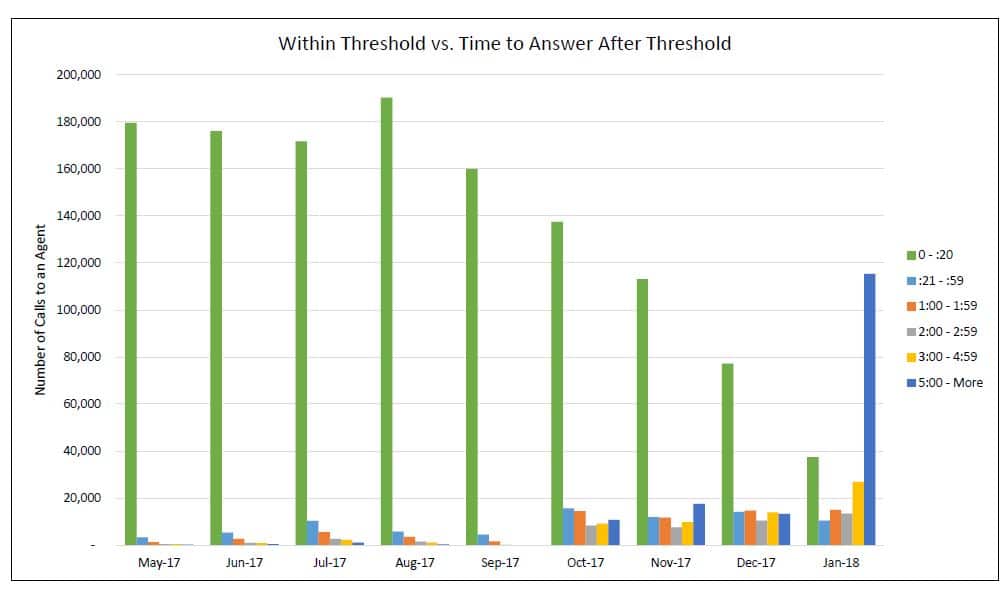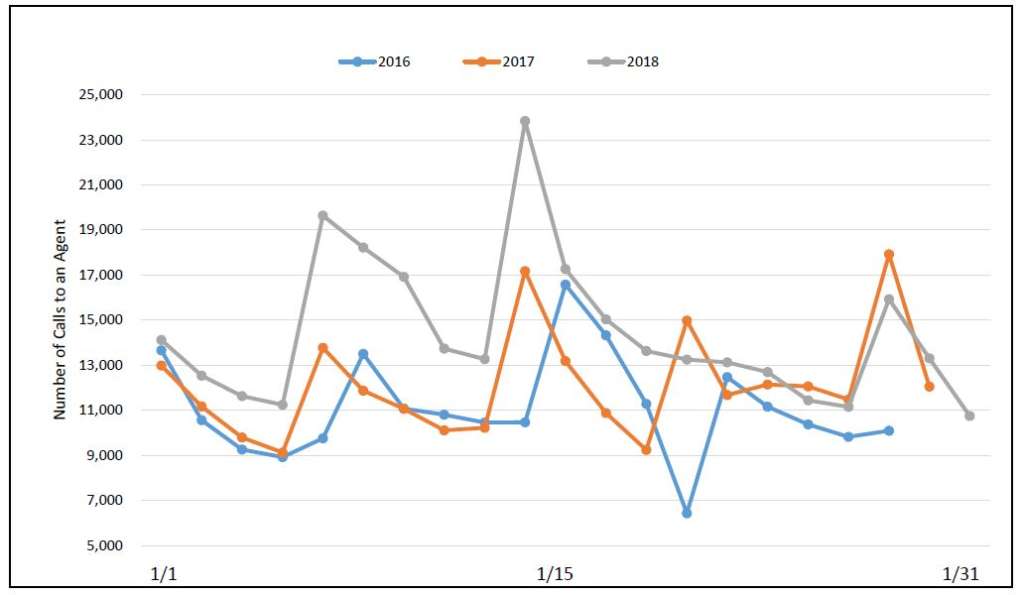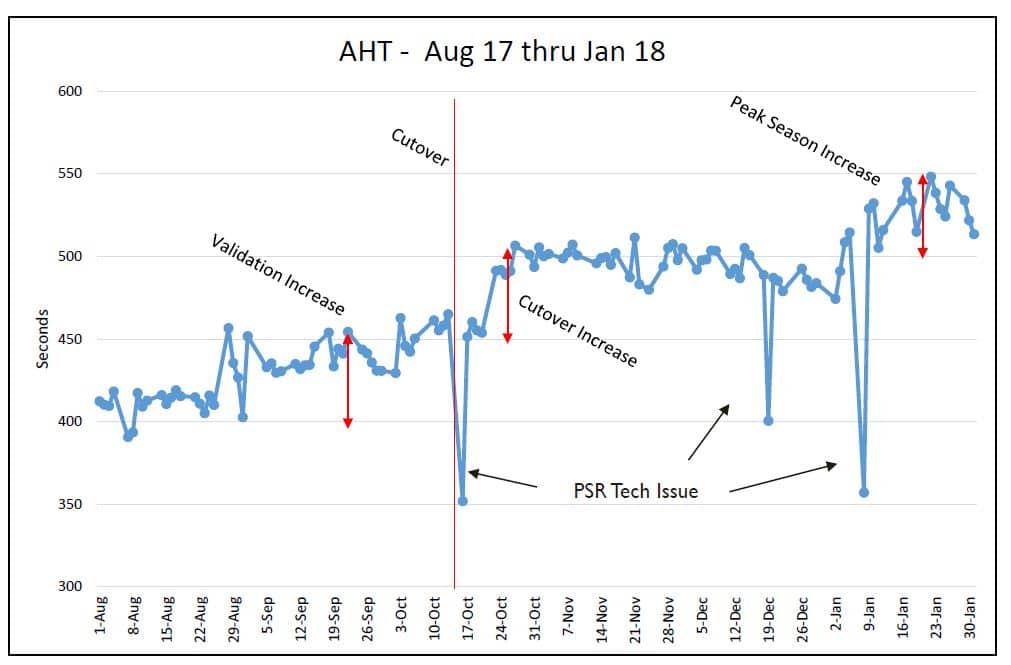
You’re not imagining it. Wait times at TSP call centers are at least 3 times longer than usual
Nearly 120,000 callers spent 5 minutes or longer waiting for a Thrift Savings Plan call representative to pick up the phone last month, a metric that's well short...
If it seems like you’ve been waiting a long time to speak to a representative on the Thrift Savings Plan’s “Thriftline” in the recent weeks and months, you have.
More TSP participants spent more time on hold this January compared to this time in 2016 and 2017, and once callers got through, Thriftline representatives took several minutes longer to resolve their questions.
Nearly 120,000 callers spent 5 minutes or longer waiting for a Thriftline representative to pick up last month. That’s well short of the TSP’s customer service goal, which charges Thriftline representatives to answer 90 percent of participants’ calls within 20 seconds or less.

The long wait times are culmination of several events, said the Federal Retirement Thrift Investment Board (FRTIB), the agency that administers the TSP.
“We’re in our seasonal high, [and] we’re struggling with high volume with the year-end of tax season,” Tee Ramos, the FRTIB’s director of participant services, said during Monday’s board meeting. “Also, we’ve had recent market volatility and some hazardous weather in January in the areas where the call centers sit, so we’re struggling.”
Like most customer service hotlines, TSP contact centers typically receive more calls from their participants in December through mid-March. But this year’s peak season is already on track to outpace the previous year’s. The agency’s call centers received more than 25,000 calls the day after Martin Luther King Jr. Day, a new record for the FRTIB.
The FRTIB is also dealing with an influx of new participants. The agency opened up the new blended retirement system to members of military on Jan. 1. So far, the FRTIB has 119,000 blended retirement participants on its system, and more are expected to join next month.
But the agency said few TSP participants are calling the Thriftline with questions about blended retirement.
Instead, more are calling with questions about new capabilities the TSP added in recent months. The FRTIB recently required all participants to set stronger passwords to access their TSP accounts online, and the agency added a relatively new function that lets users reset those passwords online.
But the root cause of longer processing times stems from the six-month IT modernization project the agency finished in October. The FRTIB completed an IT overhaul of all operational systems and hardware in the TSP’s call centers during the months leading up to “peak season.”
“We had to do a trade-off between IT security and our customer services,” Clayton Lee, program manager for the TSP’s contact centers, said Monday. “A quick implementation resulted in operational impacts. [Under] ideal goals, we would have done this in probably double the amount of time, but because of the increased emphasis on IT security and making sure our accounts are safe and our participants are whole, we had to make a risk-based decision.”
That risk-based decision had a bigger impact on TSP customer service than the agency expected, Ramos acknowledged.
Customer service agents are still getting accustomed to new IT systems and processes, Lee said, and they’re dealing with far more callers than they had before the modernization effort.

“We have resolved some capacity issues and we are now receiving more calls than we ever have before,” Lee said. “That has resolved a lot of issues. Our callers before were receiving fast busy signals or their calls were getting dropped, so the participant experience prior to the cut-over wasn’t as good as it should be.”
If participants couldn’t get through or received a busy signal in the past, callers would typically hang up and try again. But because the agency resolved the busy signal issue and quadrupled the number of lines it has open to accept callers, more participants are sitting in queue lines for longer periods and average handling time has steadily increased.

Members of the TSP board weren’t thrilled with the news that many participants had spent 5 minutes or longer waiting for an answer on the Thriftline in recent months, and with an attrition rate of 40-to-45 percent for its call center representatives, they were skeptical that the FRTIB would be able to work ahead of its staffing targets.
Lee said the FRTIB increased call center staff by 15 percent to deal with higher demand coming from service members opting into the blended retirement system. Staffing went up by another 15 percent to handle expected call volume during the current peak season.
To ease capacity and wait time challenges, the agency is extending business hours for each “Thriftline” call center and is fine-tuning the new operational processes for customer service representatives.
The call centers should see wait times and capacity challenges even out within the next three-to-four months, Lee said.
“We’re continuing, and we’ve been continuing, to add staff during this time frame,” he said. “We have a class that’s coming out of training this week. That’s going to have an immediate impact.”
Copyright © 2025 Federal News Network. All rights reserved. This website is not intended for users located within the European Economic Area.
Nicole Ogrysko is a reporter for Federal News Network focusing on the federal workforce and federal pay and benefits.
Follow @nogryskoWFED





